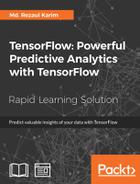You may notice that reinforcement learning jargon involves anthropomorphizing the algorithm into taking actions in situations to receive rewards. In fact, the algorithm is often referred to as an agent that acts with the environment. You can just think of it like an intelligent hardware agent sensing with sensors and interacting with the environment using its actuators.
Therefore, it shouldn't be a surprise that much of RL theory is applied in robotics. Figure 2 demonstrates the interplay between states, actions, and rewards. If you start at state s1, you can perform action a1 to obtain a reward r (s1, a1). Actions are represented by arrows, and states are represented by circles:

Figure 2: An agent is performing an action on a state produces a reward
A robot performs actions to change between different states. But how does it decide which action to take? Well, it's all about using different or a concrete policy.
In reinforcement learning lingo, we call the strategy a policy. The goal of reinforcement learning is to discover a good strategy. One of the most common ways to solve it is by observing the long-term consequences of actions in each state. The short-term consequence is easy to calculate: that's just the reward. Although performing an action yields an immediate reward, it's not always a good idea to greedily choose the action with the best reward.
That's a lesson in life too because the most immediate best thing to do might not always be the most satisfying in the long run. The best possible policy is called the optimal policy, and it's often the holy grail of RL as shown in figure 3, which shows the optimal action given any state:

Figure 3: A policy defines an action to be taken in a given state
We've so far seen one type of policy where the agent always chooses the action with the greatest immediate reward, called a greedy policy. Another simple example of a policy is arbitrarily choosing an action, called random policy. If you come up with a policy to solve a reinforcement learning problem, it's often a good idea to double-check that your learned policy performs better than both the random and greedy policies.
In addition, we will also see how to develop another robust policy called policy gradients, where a neural network learns a policy for picking actions by adjusting its weights through gradient descent using feedback from the environment. We will see that although both the approaches are used, policy gradient is more direct and optimistic.
The long-term reward is called a utility. It turns out that, if we know the utility of performing an action at a state, then it's easy to solve reinforcement learning. For example, to decide which action to take, we simply select the action that produces the highest utility. However, uncovering these utility values is the harder part to be sorted out. The utility of performing an action a at a state s is written as a function Q(s, a), called the utility function that predicts the expected immediate reward plus rewards following an optimal policy gave the state-action input which is shown in figure 4:

Figure 4: Using a utility function
Most reinforcement learning algorithms boil down to just three main steps: infer, do, and learn. During the first step, the algorithm selects the best action (a) given a state (s) using the knowledge it has so far. Next, it does the action to find out the reward (r) as well as the next state (s'). Then it improves its understanding of the world using the newly acquired knowledge (s, r, a, s'). However, this is just a naive way to calculate the utility; you would agree on this too.
Now, the question is what could be a more robust way to compute it? Here are two cents from my side. We can calculate the utility of a particular state-action pair (s, a) by recursively considering the utilities of future actions. The utility of your current action is influenced not just by the immediate reward, but also the next best action, as shown in the following formula:
In the previous formula, s' denotes the next state, and a' denotes the next action. The reward of taking action a in state s is denoted by r(s, a). Here, γ is a hyperparameter that you get to choose, called the discount factor. If γ is 0, then the agent chooses the action that maximizes the immediate reward. Higher values of γ will make the agent put more importance in considering long-term consequences.
In practice, we have more hyperparameters to be considered. For example, if a vacuum cleaner robot is expected to learn to solve tasks quickly but not necessarily optimally, we might want to set a faster learning rate. Alternatively, if a robot is allowed more time to explore and exploit, we might tune down the learning rate. Let's call the learning rate α, and change our utility function as follows (note that when α = 1, both the equations are identical):
In summary, an RL problem can be solved if we know this Q(s, a) function. Here comes the machine learning strategy called neural networks, which are a way to approximate functions given enough training data. Also, TensorFlow is the perfect tool to deal with neural networks because it comes with many essential algorithms.
In the next two sections, we will see two examples of such implementation with TensorFlow. The first example is a naïve way of developing a multiarmed bandit agent for the predictive model. Then, the second example is a bit more advanced using neural network implementation for stock price prediction.
